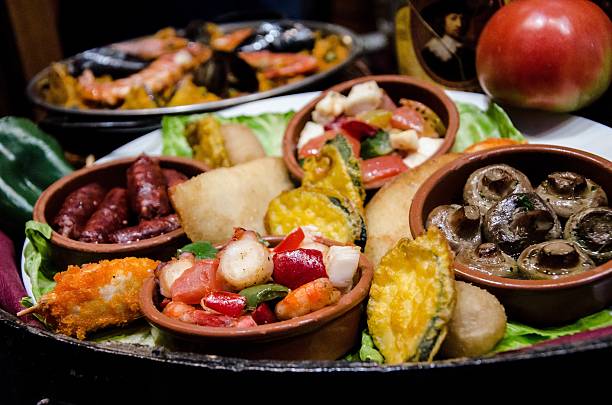Unveiling the Secrets of Spanish Tapas: A Culinary Journey
Spain, a country known for its vibrant culture and diverse landscape, is a culinary paradise. Whether it's the sizzling paella, the rich gazpacho, or the luscious flan, Spanish cuisine is a gustatory delight that's worth exploring. But nothing symbolizes the essence of Spanish food culture more than tapas.

What are Tapas?
Tapas are not just food; they’re a way of life in Spain. These small portions of food served with drinks at bars have evolved from a practical solution to keep flies away from wine glasses into a gastronomic phenomenon. They range from simple snacks like olives and almonds to more elaborate dishes like albóndigas (meatballs) and gambas al ajillo (garlic prawns).
Tapas Culture: More than Just Food
Tapas are about more than just eating; they’re about socializing. It’s common to see locals hopping from one tapas bar to another, enjoying a variety of dishes along with wine or beer. The tapas culture embodies the Spanish philosophy of enjoying life, one small plate at a time.
The Art of Pairing Tapas with Wine
The pairing of tapas with wine is an essential part of the experience. The right wine can elevate the flavors of tapas and create a harmonious culinary experience. For instance, a crisp white Albariño pairs well with seafood tapas, while a robust Rioja complements meat-based tapas.
Top Tapas to Try
While it’s hard to pick favorites when it comes to tapas, some dishes have gained iconic status. Patatas bravas (spicy potatoes), tortilla española (Spanish omelette), and jamón ibérico (Iberian ham) are just a few must-try tapas.
Innovations in Tapas
As with any culinary tradition, tapas have evolved over time. Today, many chefs are putting modern twists on classic tapas dishes, experimenting with ingredients and presentation, and creating fusion tapas that incorporate elements from other cuisines.
- Modern tapas bars often offer a wider variety of vegetarian and vegan options.
- Some chefs are embracing the farm-to-table movement, using locally sourced ingredients in their tapas.
- Fusion tapas are becoming increasingly popular, blending Spanish flavors with those from Asian, African, and other cuisines.
In conclusion, tapas are an integral part of Spanish food culture, reflecting the country’s love for good food and good company. Whether you’re a seasoned foodie or a curious beginner, embarking on a tapas culinary journey can be a delightful way to explore Spanish cuisine. So, the next time you’re in a Spanish restaurant or visiting Spain, don’t forget to try some tapas. Enjoy the flavors, enjoy the experience, and most importantly, enjoy the journey!




